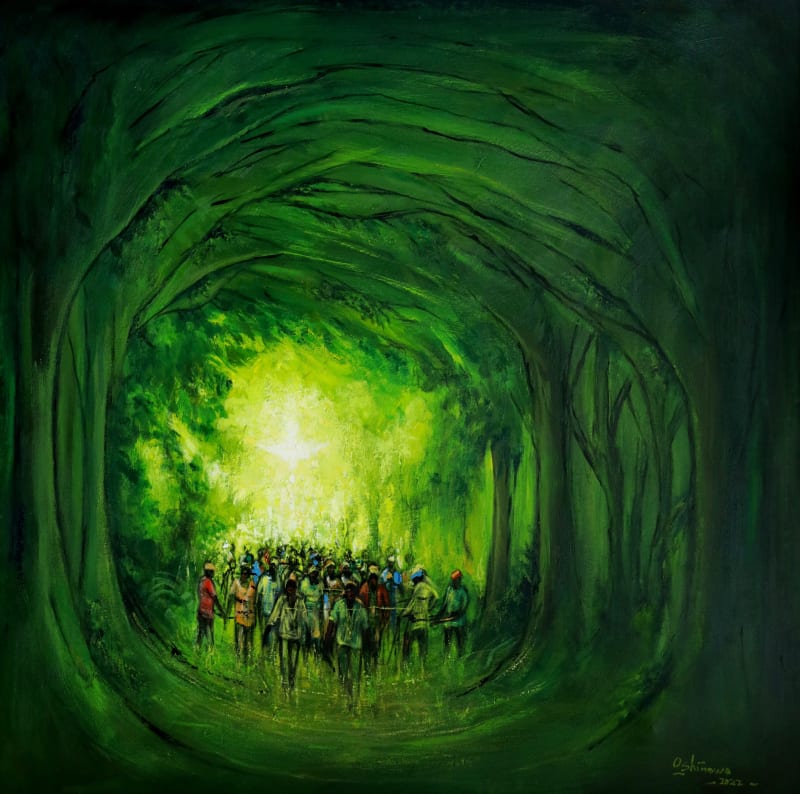Kolade Oshinowo: Enduring Passion
kó is pleased to present Enduring Passion, a solo exhibition by Kolade Oshinowo. This exhibition showcases Oshinowo’s artistic journey from the 1980s to the present, highlighting the diverse range of his work and celebrating the legacy of a national treasure.
Kolade Adekunle Oshinowo is a renowned artist recognized for his expressive and emotive paintings, often centered around the landscape and the human form. Rooted in a naturalistic style, his artwork examines the connection between individuals and their surroundings, whether in rural or congested urban spaces. Oshinowo also creates intimate portraits that capture the dignity and emotional complexity of his subjects. Oshinowo reflects on themes of uncertainty and transcendence, examining how humans spiritually connect amidst the awe of nature and their roles within the social fabric and collective existence of society.
Born in Ibadan, Nigeria in 1948, Kolade Oshinowo graduated from Ahmadu Bello University, Zara in 1972 with a specialisation in painting. His university years were shaped by the Nigerian Civil War and the influence of the Zaria Art Society, which had challenged the Western-centric approach to art education a decade earlier. Following his inaugural solo exhibition in 1973 at the Goethe Institute in Lagos, Oshinowo went on to host six solo exhibitions by the end of the 1970s and showcased his work internationally in USSR, Cuba, Romania, and India. In 1977, he exhibited at the Nigerian Exhibition of FESTAC 77. By 1984, Oshinowo was the subject of a traveling solo exhibition organised by the National Museum, which toured cities including Lagos, Benin, and Jos. To date, Oshinowo has held over twenty-five solo exhibitions. Oshinowo is the recipient of many awards, including the National Productivity Order of Merit Award of the Federal Republic of Nigeria.
Oshinowo dedicated his professional life to teaching, serving as a professor of art at Yaba College of Technology and later becoming the Head of the Department. Throughout his distinguished career, Oshinowo has been an academic and a mentor, playing a significant role in shaping the modern and contemporary Nigerian art scene for more than five decades.
In this exhibition, Oshinowo's early works underscore his long-standing interest in abstraction. Exploration (1986) and Waterfront (1990) showcase his use of gestural brushstrokes and multiple layers of paint, creating an aura-like abyss. Iya Ibeji (1997) presents the iconic mother-and-child motif as unstructured silhouettes, while Masquerades (1994) captures a group of figures in a ceremonial procession, rendered through a blurred and hazy lens. Oshinowo employs the impasto technique, thickly applying paint with visible brushstrokes to create a three-dimensional effect. In other works, he incorporates diverse materials such as oil, acrylic, charcoal, fabric, and tea and coffee stained paper.
In recent works, Oshinowo employs dramatic colors and lighting to capture surreal moments of groups within natural settings. His fascination with crowds is inspired by gatherings, festivals,markets, religious crusades, and protest rallies. He often portrays these crowds from an elevated perspective, offering a bird’s eye view from above. In Forest Whispers (2022) and Community Gathering (2023), a crowd of people gather in a forest, illuminated by piercing sunlight or by the soft glow of moonlight, tinted in green hues. Oshinowo initiated this series in 2014 in response to the abduction of the Chibok girls in Sambisa Forest, exploring how a serene forest can transform into a place of fear and chaos. In the Divine Intervention series (2021-2023), large masses of people cluster together, their formations represented through abstracted dots set against a mystical terrain. The unknown landscape could allude to ocean-scapes or mountain ranges, with the masses huddled together at the edge of uncertainty.
This exhibition also includes selections from Oshinowo’s celebrated series of portraiture, a contrast to the anonymous nature of his “crowd” scenes and depicted in a naturalistic manner. In an early work, The Model Oil (1986), Oshinowo portrays a seated woman in a moment of solitude. In Ladies in Red (2020) and Two Sisters (2021), groups of women pose in the vibrant Owambe spirit, exuding elegance, dignity, and confidence. In Before the Party (2021), a group of young girls pose in matching bright dresses, their hair adorned with jewelry and bows. Oshinowo pays special attention to the textiles and the symbolic significance of Nigerian dress culture. In these portraits, Oshinowo is interested in the character of the figures and their fashion and accessories, using them as markers for social identity. The paintings are accentuated in varying tones of red, green, or blue tones, creating a monochromatic scheme that intensifies their emotive power.
Oshinowo also responds to pressing issues of our contemporary moment. In Protest (2021), he portrays a large crowd in his distinctive style, holding Nigerian flags and protest signs. The painting serves as a poignant reference to the End SARS movement, emphasizing the collective strength and determination of the group. In The Philosopher, Adaption of Raphael Sanzio (2015), Oshinowo focuses on Nobel laureate Wole Soyinka, positioning him at the center of the composition surrounded by “disciples," in a scene reminiscent of biblical proportions. The painting reflects on Oshinowo’s engagement with important cultural figures and their role in promoting Nigeria’s intellectual discourse.
Kolade Oshinowo’s artistic journey over the last five decades attests to his mastery and versatility as an artist, showcasing his continual evolution and growth. Oshinowo’s enduring legacy continues to shape the artistic landscape, leaving a lasting mark on contemporary art.

